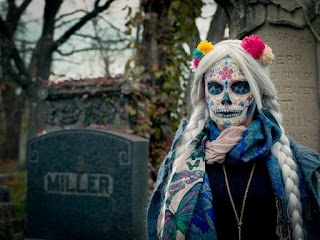A little early for Winter Tales perhaps - though recent chilly spring weather has made Winter seem an unwelcome, lingering guest.
I learned through The Bookseller that Orion are bringing out a book of Kate Mosse's supernatural short stories:
I will be interested to read how Kate deals with this traditional tale. It has been claimed by different places - but I had always thought of it as Northern. The poem on which the ballad is based though is quite different:
GINEVRA by Samuel Rogers 1822 (Public Domain)
If ever you should come to Modena,
(Where among other relics you may see
Tassoni's bucket — but 'tis not the true one)
Stop at a Palace near the Reggio-gate,
Dwelt in of old by one of the Donati.
Its noble gardens, terrace above terrace,
And rich in fountains, statues, cypresses,
Will long detain you — but, before you go,
Enter the house — forget it not I pray you —
And look awhile upon a picture there.
'Tis of a Lady in her earliest youth,
The last of that illustrious family;
Done by Zampieri — but by whom I care not.
He, who observes it — ere he passes on,
Gazes his fill, and comes and comes again,
That he may call it up. when far away.
She sits, inclining forward as to speak,
Her lips half open, and her finger up,
As tho' she said "Beware!" her vest of gold
Broidered with flowers and clasped from head to foot,
An emerald-stone in every golden clasp;
And on her brow, fairer than alabaster,
A coronet of pearls.
But then her face, So lovely, yet so arch, so full of mirth,
The overflowings of an innocent heart —
It haunts me still, tho' many a year has fled,
Like some wild melody!
Alone it hangs Over a mouldering heir-loom, its companion,
An oaken-chest, half eaten by the worm,
But richly carved by Antony of Trent
With scripture-stories from the Life of Christ;
A chest that came from Venice and had held
The ducal robes of some old Ancestor —
That by the way — it may be true or false —
But don t forget the picture; and you will not,
When you have heard the tale they told me there.
She was an only child — her name Ginevra,
The joy, the pride of an indulgent Father;
And in her fifteenth year became a bride,
Marrying an only son, Francesco Doria,
Her playmate from her birth, and her first love.
Just as she looks there in her bridal dress,
She was all gentleness, all gaiety,
Her pranks the favourite theme of every tongue.
But now the day was come, the day, the hour;
Now, frowning, smiling for the hundredth time,
The nurse, that ancient lady, preached decorum;
And, in the lustre of her youth, she gave
Her hand, with her heart in it, to Francesco.
Great was the joy; but at the Nuptial feast,
When all sate down, the Bride herself was wanting.
Nor was she to be found! Her Father cried,
"'Tis but to make a trial of our love!"
And filled his glass to all; but his hand shook,
And soon from guest to guest the panic spread.
'Twas but that instant she had left Francesco,
Laughing and looking back and flying still,
Her ivory tooth imprinted on his finger.
But now, alas, she was not to be found;
Nor from that hour could any thing be guessed,
But that she was not!
Weary of his life,
Francesco flew to Venice, and, embarking,
Flung it away in battle with the Turk.
Donati lived — and long might you have seen
An old man wandering as in quest of something,
Something he could not find — he knew not what.
When he was gone, the house remained awhile
Silent and tenantless — then went to strangers.
Full fifty years were past, and all forgotten,
When on an idle day, a day of search
Mid the old lumber in the Gallery,
That mouldering chest was noticed; and 'twas said
By one as young, as thoughtless as Ginevra,
"Why not remove it from its lurking-place?"
'Twas done as soon as said; but on the way
It burst, it fell; and lo, a skeleton,
With here and there a pearl, an emerald-stone,
A golden clasp, clasping a shred of gold,
All else had perished — save a wedding-ring,
And a small seal, her mother's legacy,
Engraven with a name, the name of both,
"Ginevra."
There then had she found a grave!
Within that chest had she concealed herself,
Fluttering with joy, the happiest of the happy;
When a spring-lock, that lay in ambush there,
Fastened her down for ever!
Will Kate use the landscape of the Languedoc or the Weald to colour her work? I know The Wedding Ghost has more than a hint of the misty Sussex coast about it.


.jpg)



.jpg)






,+1804via_liquidnight_tumblr.jpg)






_Chicagogeek_No+_remix.jpg)

.jpg)

.jpg)


.jpg)






.jpg)